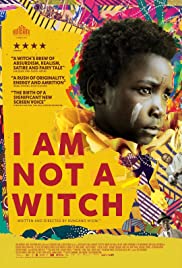
I AM NOT A WITCH
UK, Zambia, 2017, 85 minutes, Colour.
Maggie Mulubwa, Henry B. J. Phiri.
Directed by Rungano Nyoi.
The setting for this film is Zambia. The director was born in Zambia but left at an early age and grew up in the United Kingdom. This film has won many awards, many nominations, especially in the UK.
Audiences will have a response to witches – especially as they see the tourists in their bus, going to look at the witches, middle-aged and elderly women, faces painted, sitting in rows for observation. The witches are then sent out in the fields, working hard, but always with a ribbon of their back leading back to a winch, able to control all their movements. However, they live in some kind of camaraderie and community.
The focus of the film is on a young girl, no explanation of her origins, being interrogated by the police, condemned by people as a witch. She is offered the option of choosing to be a witch or a goat. She chooses to be a witch and goes out into the feels, ribbon attached.
However, a government official takes a liking to her, using her and her alleged powers in lineups to decide who is the guilty party (the young girl phoning her grandmother for advice: the most nervous -looking). The young girl is good at this work, accepted by the official, taken to visit his lavish home, even going on a television talk show.
However, the young girl is oppressed – and makes the final decision to become a goat rather than a witch, which leads to her death.
The film serves as a metaphor for the treatment of women in society, with particular focus on African society and witches. It also serves as a metaphor for the abusive and oppressive treatment of children.
This is the 21st-century, with many dark traditions from the past, the status of women, but in the modern era everyone with their mobile phones, even the young witch, headphones and music, modern farming equipment – and even a talk show where the government official and the young witch are interrogated.
- Audience response to the theme of witches? Western traditions and persecutions? Fears? Women? African traditions, witch doctors, the treatment of women named as witches?
- The title, the focus on the big number of witches, on Shula?
- The Zambian setting, the location photography, out in the fields the roads, the homes? The confines for the witches? The contrast with the lavish mansion and furnishings? The television studio? Zambia in the 21st-century? The musical score?
- The tourists visiting the witches, the ironic comment on tourist curiosity, exploitation of the women? The large number, painted faces, sitting in rows?
- The treatment of the witches, named as witches, their ages, going to work in the fields? The significance of the ribbons? On their backs? Tied to the winches? Controlling their movements, even at work? The women and their acceptance of this? The community, camaraderie?
- Shula, the little girl, the question is, the interview with Inspector Josephine, the witnesses against her, the people outside the window condemning her? Her being taken, the ribbon, control, with the other women? At work?
- Mr Banda, a government official, his interventions, the role of the witch, becoming his protégé, protecting her, her privileges, yet the control, the ribbon? In the case, ringing her grandmother, the criteria for judging the criminal? Her decision, the man and his reaction, travelling on the bus, condemnation?
- Mr Banda, his satisfaction, taking Shula with him, her growing confidence? The lineup and her picking the criminal?
- The visit to Mr Banda’s house, the woman, living in comfort, her explanation of her history, acquiescing in everything asked of her, still controlled? Her support of Shula?
- The irony of the television appearance, the talk show, the questions, the audience, Mr Banda making a good impression about himself, Shula silent?
- The effect of the experience, the previous option of being a witch or a goat, her deciding that a goat would have been better, even if eaten as threatened?
- Her final choice, her death, the women finding her, the red clothes, mourning her?
- The comment on the role of women in this Zambian society? Women subservient, witches, working in the fields? The young witch, a metaphor of the oppressive and abusive treatment of young girls?